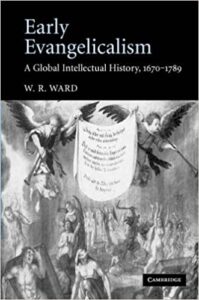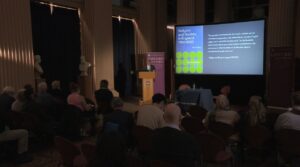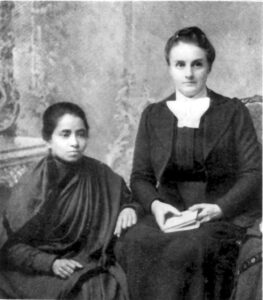Lecture 4: The Protestant International: Pietism, Premillennialism, and Pentecostalism
After a half-rainy, half-sunny venture to St Andrews for the weekend, Professor Hempton returned to deliver his fourth lecture of the series. Below is a short summary, followed by a reflection from a PhD Candidate in Christian-Muslim relations Nathan Dever, and the lecture video. The summary follows the structure of Professor Hempton’s lecture and is split into three parts.

Pietism
Hempton begins by reflecting on the work of William Ward, the historian of Protestant International who worked in ‘opposition to what he considered to be the then dominant paradigms constructed by Anglican chauvinists, Marxist reductionists, sentimental religious ecumenists, and parochial Anglo-American religious historians.’ Ward, when exploring religion in revolutions, focused on the evangelicals of Manchester, rather than the elites of Paris or London. Beginning in the ‘dark mills’ of this industrial city, Ward then explored outwards to argue against Owen Chadwick’s ‘Anglican airbrushing of Methodism,’ and E. P. Thompson’s portrayal of Methodism as a proletarian disease. Ward’s publications explored the roots and reasons for the success of the Free Churches, leading him to believe that ‘in Europe after Westphalia religion was too important a matter to be left entirely to the churches.’ Established churches succumbed to or were forced into political quarrels, leaving space for ‘a new and dynamic religious movement, evangelical revivalism’ that was not dependent on the State and mobilised the laity to finance and spread the church’s mission.
Ward reflected on how early evangelicalism united around certain themes (notwithstanding their bitter disagreements around others), ‘the close association with mysticism, the small-group religion, the deferred eschatology, the experimental approach to conversion, anti-Aristotelianism and hostility to theological system, and the attempt to reinforce religious vitality by setting it in the context of a vitalist understanding of nature … formed a sort of evangelical hexagon lasting until the original evangelical cohesion began to fail’ (Early Evangelism: A Global Intellectual History 1670-1789, 2006). In contrast to the later, rigid system that makes up evangelicalism, the early movement drew from eclectic ideas and changing intellectual and social contexts.

The rise of the French Revolution also gave motivation for spreading these ideas, to create ‘an alternative global ideology, a rival cosmopolitanism with its metropolitan base in London, and soon New York, to the ‘Rights of Man’ with its metropolitan center in Paris.’ Some of the most well known missionary networks to arise between 1790 and 1814 include the Baptist Missionary Society (1792), the (London) Missionary Society (1795), the Edinburgh (Scottish) and Glasgow Missionary Societies (1796), and in the US arose the New York Missionary Society directly following the LMS, the Berkshire and Columbia Missionary Society (1798), the Missionary Society of Connecticut (1798), the Massachusetts Missionary Society (1799), the New Hampshire Missionary Society (1801), just to name a few. Even within these smaller US societies, the members saw themselves as part of a larger, Gospel sending network.
Premillennialism
The growing influence of evangelicals in British society however coincided with the growth of the British Empire, especially in India and its role in the transatlantic slave trade. ‘Not surprisingly with such profound issues at stake the surge of interest in missions was accompanied by a parallel surge of interest in biblicist millennialism, of both the optimistic variety emphasizing the millennial advance of the Gospel and also a more pessimistic, but equally energetic pre-millennial version that interpreted the signs of the times as so grim that only the returning Christ could save the godly from further trials and tribulations.’ Resistance to ideas just as Jacobinism, slavery, Romanism and infidelity moved to the forefront. This age of revolutions also provoked a ‘heightened anxiety’ resulting in ‘the remarkable proliferation of interest in apocalypticism.’ Christians in the US and British Isles searched the scriptures for clues about the end times, the fate of the Jews, and the second coming of Christ. Theology was turning its back on ‘predestinarian Calvinism’ and its views of human depravity towards postmillennialist human advancement. This also changed society. Leading to the views of Adam Smith, the epitome of views about economic progress and conservative theological and political ideals.
There were diverse ideas surrounding apocalyptic theologies and ideologies, but there also existed some basic tenants of the ‘millenarian creed.’ Namely, inerrancy of the bible- to the extent of real expectation of biblical prophecies, that the world was running towards the last judgement, Christ would literally return to the earth, and that Jews had to return to Palestine. One famous premillennial historicist even produced charts that mapped time according to this theology. John Nelson Darby is another influential figure. From South County Dublin in the 1830’s he used the context of impending defeat of Anglo-Protestant ascendancy to explore biblical prophecy. ‘Darby affirmed the secret rapture of the saints and took a literal view of the Tribulation, Armageddon, and the millennium.’ The method of storytelling and capturing his audience led to the eventual rearrangement of the two biblical scriptures. The node here being the radical evangelical Irish men, the nucleus being ‘the emerging dispensational premillennial scheme of human history and human destiny’ and the networks somewhat moving across Europe and North America with Darby visiting America 7 times. Darby was honoured with Oxford University Press publishing the Scofield Reference Bible in 1909, the best-selling Oxford University Press book of all time. This network was also bolstered by journals such as Horae Apocalypticae, Quarterly Journal of Prophecy and the Prophetic Times all released between 1844-1863. Hempton suggests, ‘it is hard to resist the conclusion that it operated as a kind of male, English-speaking book club, with the Bible as the book and the prophecies operating as clues to unlocking the secret history of time.’

This tradition in the United States is better known today. ‘In the United States these networks were trans-denominational, transcended social class, were not confined to specific regions, and were predominantly comprised of comfortable white males who had the resources and know-how to travel.’ The American tradition encompassed ‘resistance to the three r’s of rationalism, romanism, and ritualism, hostility to modernism, theological liberalism, and biblical criticism, forebodings of the threats posed by scientific naturalism (especially Darwinism) and urbanization, anxiety about heresies from within, and finally fear of the international challenges of ecumenism, socialism, and communism.’ Dwight L. Moody, Reuben A. Torrey, C. I. Scofield, William Erdman, and A.J. Gordon stand out as important leaders. The election of Ronald Reagan and Donald Trump speak to the longevity of these ideas.
Pentecostalism
In the final section of the lecture, Hempton sought to show how the Pentecostal movement, now incorporating at least ½ billion people, does not have a clean-cut origin place. Although the Azusa Street Revival of 1906 is a significant nodal point, it is not the earliest or the most important. ‘Contemporary with the Azusa Street revival, but starting earlier and not directly influenced by it, there was tongue speaking and prophesying in the Mukti revival associated with Pandita Ramabai, which in turn was influenced by the Australian revival of 1903 and the Welsh revival of 1904-5. Within a decade of Azusa Street there were revivals with pentecostal characteristic, but without known direct contacts with Los Angeles, in Korea, China, India, Chile, Nigeria, and the Ivory Coast.’
Though Hempton also stresses the reality of the Protestant network creating the ideal breeding ground for Pentecostalism to thrive. The emphasis on personal salvation, Holy Ghost baptism, divine healing, and dispensational premillennialism through networks such as conferences, summer camps, books, magazines, colleges, Bible institutes, and a web of national, regional, and local associations assured the transmission of Pentecostal awakenings. Hempton uses the metaphor of fireworks display to describe how encounters between black Americans, Hispanics and poor whites met in a baptism of Holy Spirit. The reality, rather than being American centred however was a string of firecrackers, with different centres being hit with a Pentecostal fire.
‘As for the nucleus of Pentecostalism, most would locate it in the experience of Holy Spirit baptism and the spiritual gifts accompanying it, but Wacker, while not denying the centrality of spirit baptism, finds the essence of Pentecostalism in a combination of primitivism and pragmatism – a direct unfiltered experience of divine power and intimacy on the one hand, and a realistic grasp of temporal realities and necessities on the other.’ The gift of Pentecostalism was its ability to contextually adapt, and often without being anti-colonial, it could exist in the space of decolonialisation. An interesting reflection from David Martin is that Pentecostalism represents the mobilization of a minority people at the margins of the world, not a structured system that feeds into power structures. One person who fits this definition, of how Pentecostalism empowered somebody on the margins is the life of Minnie Abrams, who left behind a book The Baptism of the Holy Ghost & Fire (1906) that made its way through the Pentecostal women’s networks. Abrams, born in Wisconsin, went to India as a missionary of the Methodist Episcopal Church in 1887 and left that position a decade later to work with the Mukti mission in Kedaon. As awareness spread of the 1904 Welsh Revival among mission stations, a Pentecostal revival began at the Mukti mission in the summer of 1905, the year before the Azusa Street revival,’ and her book brings together her holiness spirituality, missionary experience and Spirit baptism.
Conclusion
I will conclude in a large Schleiermachan style sentence that sums up Hempton’s 10 concluding points. We see in this lecture that the bible is an enduring window that inspires the work of all these movements, that we rely on organised institutions as historians to trace these trans-national and trans-denominational networks, the use of print culture and emerging technologies, the critique of worldliness to inspire religious revivals, the relationship with the context, the importance of women (to be continued tomorrow), the energy from the nucleus, their vulnerability to power contests between entitled men, the importance of transmission sites, and the reality that the Protestant International is a cause and consequence of globalisation.
Reflection
The Effectiveness of Applying Networks, Nodes and Nuclei to the Protestant International.
As part of the historic Gifford series at the University of Edinburgh, over the last week Professor David Hempton has delivered a series of lectures under the heading of ‘Networks, Nodes, and Nuclei in the History of Christianity, c. 1500-2020.’ Most recently professor Hempton gave his fourth lecture, which like his previous three, proved to be as fascinating as it was wide ranging. Entitled ‘The Protestant International: Pietism, Premillennialism and Pentecostalism,’ I found this lecture to be insightful, informative, and provocative. In particular, I found it to be a useful context in which to consider what seems to me perhaps the series’ most interesting contribution – its methodological approach. This is to say, what I have been consistently struck by in Hempton’s work has not so much been its contributions to questions of what we know about the history in question – though this has by no means been trivial – but rather its contribution to how we know this history.
Professor Hempton’s focus in this lecture is on what he terms ‘the Protestant international;’ a grouping of events which he describes as ‘some of the most significant developments in the English-speaking Protestant world in the past four centuries.’ These events include ’the transition from pietism to evangelicalism, the explosive growth of Protestant missions, the origins of premillennial dispensationalism’ and the ‘the worldwide spread of Pentecostalism.’ While recognizing their importance though, given their disparate nature, professor Hempton is quick to point out that ‘none of these developments can be studied within a single denominational or national tradition.’ Thus, Hempton brings us back to the importance of network analysis. Rendering the topic in the particular language of his methodology, he deemphasizes official categories of affiliation, and instead highlights the ‘nucleus of ideas/theologies, the nodal points of their transmission and dissemination, and the transnational networks that facilitated their growth.’
This is the first point which I would like to highlight. Though Professor Hempton has made a similar move in his other lectures, I believe it is especially effective in the context of ‘the Protestant International,’ and by extension, the study of evangelicalism as a whole. As the term ‘evangelical’ has come to encompass such a wide range of individuals and denominations, numerous scholars have begun to question whether the term itself might be obsolete. Indeed, as Molly Worthen has noted, given its lack of a central ecclesiastical authority, attempts to doctrinally define the term ‘evangelical’ necessarily yield flattened and incomplete pictures. Yet at the same time, the term remains ubiquitous in scholarly literature, and is a cherished descriptor for many Christians themselves. In light of this then, what I believe professor Hempton does so successfully in this lecture is suggest a mode of analyses which is flexible enough to capture the diversity of ‘evangelicalism,’ while at the same time, cohesive enough that the term ‘evangelical’ can still be convincingly operationalized.
Moving on, a second closely related point can be made in reference to Hempton’s discussion of John Nelson Darby and the development of dispensational premillennialism. Centered around the ‘node’ of County Wicklow and south County Dublin in the early nineteenth century, Hempton efficiently traces the nucleus of dispensational thought as it spread outwards, noting in particular its profound impact on American evangelicalism. Certainly, much attention has been paid to dispensationalism, its origins, and its impact on evangelicalism. But again, I believe it is important to focus on the strength of Hempton’s work here less in terms of a what and more in terms of a how . For especially in a Euro-American context, the groups which Hempton describes have so often been turned into analytical black boxes. Mapped onto the latter end of a ‘moderate – fundamentalist’ spectrum, such groups tend to be labelled anti-intellectual, thereby precluding analyses which seriously grapple with their ideas. In stark contrast though, Hempton’s work intentionally takes seriously the ideational aspect of this history in a manner which, together with careful contextualization, produces a unique, analytically rich picture.
Finally, Professor Hempton’s discussion of Pentecostalism’s global advance illustrates a third strength of the lecture. This is its acknowledgement of the paradoxes and ambiguity of the history it treats. Narrating the spread of Pentecostalism, Hempton makes clear the importance of events in the United States to the Pentecostal movements that emerged in Africa, Asia, and South America, yet does so without making the latter derivative of the former. In this way, something which Hempton’s work does so well here is to avoid the pitfalls of an uncritical post-colonialism. One which ironically denies agency to those it claims to ‘liberate’ by policing the boundaries of ‘authenticity,’ thereby acting as a form of governmentality no less invested in the management of ‘native’ subjectivities than the colonialism it ostensibly opposes. Similarly, Hempton also engages the ambiguity of women within this history. Noting the unique opportunities for leadership afforded to women throughout the history of Pentecostalism – and indeed of ‘the protestant international’ more generally – he also forthrightly acknowledges the reality of these movements as deeply patriarchal.
This final strength notwithstanding though, it is this ambiguity which it would be interesting to see Hempton explore further. For while he does explicitly acknowledge that ‘none of the transformations dealt with…can be understood without a deep understanding of the economic, social, and political conditions which shaped them,’ there is also a tendency to juxtapose formal institutions with informal ones in a way which can obscure how power operates freely across such divides. To put this more directly, and to use the above example of Pentecostalism and anti-colonialism, while this by no means invalidates the agency of individuals to genuinely adopt and inhabit Pentecostalism as something on their own terms, it is nonetheless also important to consider the profundity of a kind of epistemological power bound up in colonialism and Protestant missions that has the ability to shape the grammar both of its supporters and opponents.
Lecture Video




Just to reiterate how superb are these summaries and responses. It is such a delight for me as the lecturer to see that the ideas I am trying to get across are getting across and that they are stimulating debate both for their strengths and their weaknesses. I especially appreciate Nathan’s comment that the lectures in general, and this one in particular, are not just about extending what we know about the past, important though that is, but how we know it. These are methodological, historiographical, and epistemological questions of enormous complexity. I particularly appreciate the concluding sentence which gets to the heart of the ambiguities inherent in my methodology around religious networks and the structural realities of power and how it is exercised in colonial contexts. His statement that colonialism and Protestant missions help shape the grammar of both opponents and supporters is particularly sharp. Thank you!